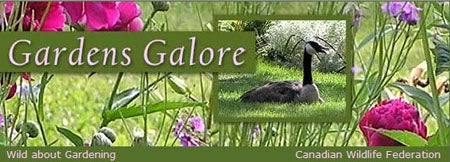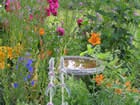
Text and photos by Nia and Ralph Massey
Set amidst Manitoba's fields and wetlands lies the home of Nia and Ralph Massey. Their seven-acre property, once wheat fields and a small patch of grass, now consists of three acres of cultivated gardens, a hay field and an acre of original bushland along the water (river, creek and marsh).
The Masseys, who share a love of flowers and an appreciation for wildlife, have found that they can enjoy both gorgeous gardens and nature. They have, in their casual yet creative way, made their outdoor space equally hospitable to both human and wild neighbours.

And others still, like the Dike Garden, are perfect examples of how the Masseys turned adversity into opportunity. They transformed the barren remains left after the removal of sandbags put in place in precaution of a 1997 flood. The resulting Dike Garden “is a mixture of everything but is geared towards plants that attract birds,” says Nia, although other winged creatures like butterflies benefit as well. The plants in the Dike Garden include Echinacea, Gaillardia, juniper, Monarda, Liatris, swamp milkweed and lilies.
The Bedroom Garden is what Nia calls the “free spirit garden” because “it does its own thing and is different every year.” This is home to obedient plant, meadowsweet, valerian, lilies and more. It was once the bedroom of the cottage but due to flood damage the bedroom was relocated and a new garden was born.

Certain animals are often considered a nuisance, but the Masseys work with nature to get the best of both worlds, as demonstrated by the Goose Garden. “It started from a large lump of sod that was pushed up and scraped by the ice and made it difficult to mow. It is called the goose garden because it is a favourite place of Canada geese to laze about in the shade during summer. It, too, has been enlarged over the years. Last year, we put a small willow fence around it and this has kept the geese from lying in the centre. Its theme is yellow and orange with silver.”

While the gardens feature many non-native plants like peonies, native plants are incorporated both in and amongst the garden beds. Some bear fruit, others seeds and all produce flowers that are enjoyed by a variety of beneficial insects and other pollinators, such as hummingbirds and butterflies. There is a mix of trees, shrubs, vines and perennials, including wild rose, hawthorn, Virginia creeper, hazelnut, birch, chokecherry, gooseberry, goldenrod, Joe-pye weed, wild columbine, white spruce and balsam fir. All plants are left to go to seed for winter birds. There is also an acre of natural bush along the river.
The plants also provide shelter — a place to escape the cold winter winds or hot summer afternoons and a place to nest, perch and hide from predators. The Masseys have supplemented this natural shelter with bat houses and many bird houses, including ones for wood ducks. They have also left dead trees standing and allowed some areas to grow tall and wild.

Natural water sources, in the form of the river and creek, are supplemented with bird baths and a pond. The manufactured stream running into the pond is a favourite bathing spot of pine siskins, sparrows, warblers and gold finches. They “line up on the fence to take their turn for a bath,” says Nia. The Masseys also employ “green” principles including leaving their grass clippings on the lawn, using a composter and watering their lawn as seldom as possible.
This variety of habitat features, as well as the shoreline that was left in its natural state, accommodates a wide assortment of animals as their list of visitors will attest. Their efforts have enticed frogs, toads, squirrels, muskrats, foxes, skunks, otters, deer, mink and 80 to 100 species of bird to visit each year.
Whatever your gardening style, be it formal and elegant, cottagey, or more along the philosophy of letting nature do all the gardening for you, click here to find out about our Backyard Habitat Certification program which recognizes efforts that provide food, water, shelter and space for wildlife.
